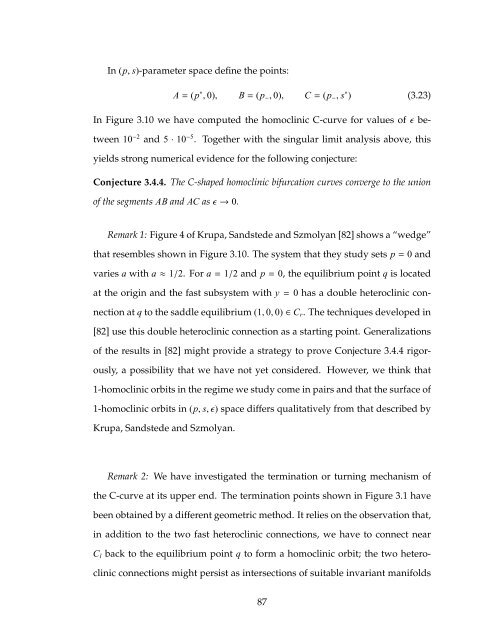multiple time scale dynamics with two fast variables and one slow ...
multiple time scale dynamics with two fast variables and one slow ...
multiple time scale dynamics with two fast variables and one slow ...
You also want an ePaper? Increase the reach of your titles
YUMPU automatically turns print PDFs into web optimized ePapers that Google loves.
In (p, s)-parameter space define the points:<br />
A=(p ∗ , 0), B=(p−, 0), C= (p−, s ∗ ) (3.23)<br />
In Figure 3.10 we have computed the homoclinic C-curve for values ofǫ be-<br />
tween 10 −2 <strong>and</strong> 5·10 −5 . Together <strong>with</strong> the singular limit analysis above, this<br />
yields strong numerical evidence for the following conjecture:<br />
Conjecture 3.4.4. The C-shaped homoclinic bifurcation curves converge to the union<br />
of the segments AB <strong>and</strong> AC asǫ→ 0.<br />
Remark 1: Figure 4 of Krupa, S<strong>and</strong>stede <strong>and</strong> Szmolyan [82] shows a “wedge”<br />
that resembles shown in Figure 3.10. The system that they study sets p=0 <strong>and</strong><br />
varies a <strong>with</strong> a≈1/2. For a=1/2 <strong>and</strong> p=0, the equilibrium point q is located<br />
at the origin <strong>and</strong> the <strong>fast</strong> subsystem <strong>with</strong> y=0 has a double heteroclinic con-<br />
nection at q to the saddle equilibrium (1, 0, 0)∈Cr. The techniques developed in<br />
[82] use this double heteroclinic connection as a starting point. Generalizations<br />
of the results in [82] might provide a strategy to prove Conjecture 3.4.4 rigor-<br />
ously, a possibility that we have not yet considered. However, we think that<br />
1-homoclinic orbits in the regime we study come in pairs <strong>and</strong> that the surface of<br />
1-homoclinic orbits in (p, s,ǫ) space differs qualitatively from that described by<br />
Krupa, S<strong>and</strong>stede <strong>and</strong> Szmolyan.<br />
Remark 2: We have investigated the termination or turning mechanism of<br />
the C-curve at its upper end. The termination points shown in Figure 3.1 have<br />
been obtained by a different geometric method. It relies on the observation that,<br />
in addition to the <strong>two</strong> <strong>fast</strong> heteroclinic connections, we have to connect near<br />
Cl back to the equilibrium point q to form a homoclinic orbit; the <strong>two</strong> hetero-<br />
clinic connections might persist as intersections of suitable invariant manifolds<br />
87
















